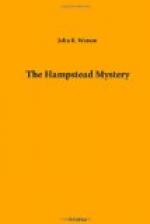Mr. Walters in his opening address paid tribute to the exceptional circumstances of the case by some slight show of nervousness. Several times he insisted that the case was what he termed unique. The prisoner in the dock was a man who by his distinguished abilities had won for himself a leading position at the bar, and had been honoured and respected by all who knew him. It was not the first occasion that a member of the legal profession had been placed on trial on a capital charge, though he was glad to say, for the honour of the profession, that cases of the kind were extremely rare. But what made the case unique was that it was not the first trial in connection with the murder of Sir Horace Fewbanks, and that at the first trial when a man named Frederick Birchill had been placed in the dock, the prisoner now before the court had appeared as defending Counsel, and by his brilliant conduct of the defence had materially contributed to the verdict of acquittal which had been brought in by the jury. Some evidence would be placed before the jury about the first trial and the conduct of the defence. He ventured to assert that the jury would find in this evidence some damaging facts against the prisoner—that they would find a clear indication that the prisoner had defended Birchill because he knew himself to be guilty of this murder, and felt an obligation on him to place his legal knowledge and forensic powers at the disposal of a man whom he knew to be innocent. At the former trial the prisoner, as Counsel for the defence, had attempted to throw suspicion on a man named Hill, who had been butler to the late Sir Horace Fewbanks, but evidence would be placed before the jury to show that in doing so the prisoner had been smitten by some pangs of conscience at casting suspicion on a man who he knew was not guilty.
It was not incumbent on the prosecution to prove a motive for the murder, continued Mr. Walters, though where the motive was plainly proved the case against the prisoner was naturally strengthened. In this case there was no doubt about the motive, but the extent of the evidence to be placed before the jury under that head would depend upon the defence. The prosecution would submit some evidence on the point, but the full story could only be told if the defence placed the wife of the prisoner in the witness-box. It was impossible for the prosecution to call her as a witness, as English law prevented a wife giving evidence against her husband. She could, however, give evidence in favour of her husband, and doubtless the defence would take full advantage of the privilege of calling her.




